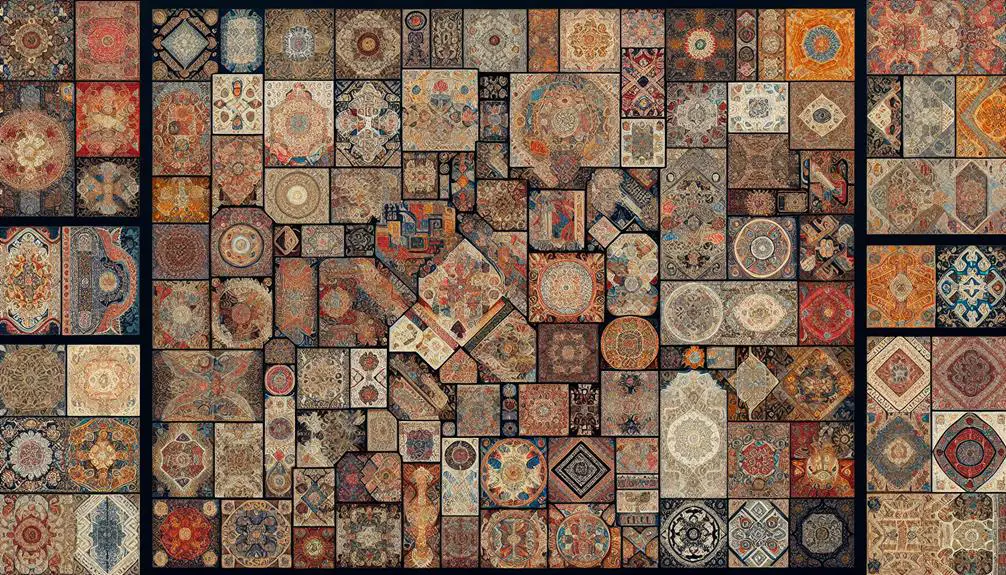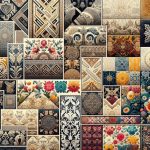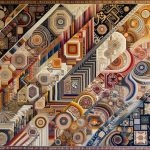Imagine the tapestry of history, woven with threads of innovation and cultural exchange, each pattern telling a unique story. As you delve into the evolution of textile patterns, you'll uncover how ancient civilizations mastered intricate loom techniques and how medieval tapestries reflected societal values. The Renaissance era introduced advanced brocade methods and floral motifs, while colonial times integrated global designs. The industrial revolution transformed production, paving the way for modern trends focused on sustainability and technology. Curious about how these changes have shaped the textiles around you? Let's start on this fascinating journey together.
Table of Contents
Key Takeaways
- Early loom techniques in ancient civilizations required skill and reflected cultural significance through symbolic patterns and natural dyes.
- Medieval Europe saw intricate textile patterns from skilled craftsmen in guild workshops, often depicting historical and mythological scenes.
- The Renaissance introduced floral motifs and advanced brocade techniques, enhancing textile intricacy and symbolizing status.
- Colonial influences integrated exotic materials and motifs, with trade routes spreading diverse designs and fostering cultural fusion.
- The Industrial Revolution mechanized textile production, introducing the Jacquard loom and shifting social dynamics with factory systems.
Ancient Civilizations
In ancient civilizations, textile patterns often reflected cultural values and societal norms. You'd find that early loom techniques were both innovative and complex, laying the groundwork for the textiles we see today. Mastering these techniques required not just skill but also a deep understanding of the materials at hand. You'd need to know that the dyeing methods used were equally sophisticated. Natural dyes derived from plants, insects, and minerals were meticulously prepared to achieve the desired hues and shades.
Textiles weren't merely functional items; they held symbolic meanings and cultural significance. In many cultures, specific patterns and colors were imbued with meanings that signified social status, religious beliefs, or even political affiliations. For example, intricate geometric patterns could represent the cosmos, while certain colors might denote royalty or divinity.
Understanding the cultural significance of these textiles requires an appreciation for the context in which they were created. Early loom techniques and dyeing methods weren't just about producing cloth; they were about crafting a piece of history, woven and dyed with stories, beliefs, and values that defined entire civilizations.
Medieval Europe
During Medieval Europe, textile patterns became increasingly intricate, reflecting the era's artistic and social complexities. You'd notice that textile artisans operated within guild workshops, which served as hubs for creativity and skill refinement. These guilds ensured that only the most skilled craftsmen could create and market their textiles, leading to a high level of quality and consistency.
Guild workshops were more than just places of work; they were centers of innovation where techniques were perfected and passed down through generations. As a result, patterns grew more elaborate, featuring motifs like flora, fauna, and geometric shapes that told stories or symbolized status. Fabrics became a canvas for artistry, with each piece reflecting the weaver's expertise and the cultural narratives of the time.
Tapestry art, particularly, flourished during this period. These woven masterpieces weren't merely decorative but served as historical records and status symbols. You'd find that tapestries often depicted scenes from mythology, religion, and daily life, rendered in vibrant colors and intricate designs.
This art form required immense skill and time, making tapestries highly valued possessions among the nobility and clergy, further solidifying the role of textiles in medieval society.
Renaissance Innovations
During the Renaissance, you'll notice the emergence of intricate floral motifs that added elegance to textiles.
This period also saw significant advancements in brocade techniques, enhancing the texture and richness of fabrics.
These innovations transformed textile patterns and set new standards in artistry and craftsmanship.
Floral Motifs Emergence
You can trace the rise of floral motifs in textile patterns back to the innovative spirit of the Renaissance. This era's artists and designers were captivated by the natural world, drawing botanical inspiration and giving it an artistic interpretation that transformed textiles. These floral designs weren't merely decorative; they carried nature symbolism and were often imbued with intricate details that highlighted the Renaissance's love for complexity and craftsmanship.
To master the understanding of this period's floral motifs, consider the following elements:
- Botanical Inspiration: Designers studied plants meticulously, replicating their forms and colors.
- Artistic Interpretation: Rather than exact replicas, they added stylized flourishes, making each piece unique.
- Nature Symbolism: Flowers and plants symbolized various virtues and ideas, like purity and growth.
- Intricate Details: The patterns showcased fine lines and elaborate compositions, reflecting advanced weaving skills.
- Cultural Exchange: Trade routes introduced exotic plants, enriching the diversity of floral motifs.
Brocade Techniques Advancement
Building on the intricate floral motifs, the Renaissance also saw groundbreaking advancements in brocade techniques that revolutionized textile patterns. During this period, you'd witness the perfection of weaving techniques that allowed for more intricate and luxurious fabrics. Master weavers integrated metallic threads and vibrant silks, creating brocades that shimmered and captured light in ways previously unimaginable.
As an enthusiast seeking mastery, you'll appreciate how these advancements weren't just technical but also elevated artistic expressions. Brocade designs began to feature intricate scenes, mythological figures, and elaborate decorative elements, transforming textiles into opulent works of art. The interplay of texture and color in these fabrics added depth and complexity, making each piece a masterpiece.
You'll also find that these innovations held profound cultural significance. Brocade textiles became symbols of status and power, often used in courtly attire and ecclesiastical vestments. The luxurious materials and elaborate patterns communicated wealth and sophistication, becoming integral to the cultural fabric of the Renaissance.
Colonial Influences
As you explore colonial influences, you'll notice European designs merging with local aesthetics, creating unique textile patterns.
Trade routes played a vital role in spreading these designs, introducing new materials and techniques.
This cultural exchange fostered a rich tapestry of patterns that reflected the interconnected world of the colonial era.
European Design Integration
Many textile patterns in Europe began to reflect intricate designs influenced by colonial encounters, showcasing a blend of indigenous motifs and European aesthetics. You'll notice that textile technology played a pivotal role in this cultural fusion.
European designers adapted advanced weaving and dyeing techniques to incorporate elements from various colonies, creating unique and sophisticated patterns. This integration wasn't just about aesthetics; it was a profound exchange of artistic traditions.
Consider these key elements of European design integration:
- Intricate Motifs: European textiles began to feature complex patterns inspired by Indian, African, and Southeast Asian designs.
- Color Palettes: The introduction of vibrant, previously unseen colors from colonial regions enriched European textile palettes.
- Material Use: Exotic materials such as cotton and silk, sourced from colonies, became staples in European textile manufacturing.
- Symbolism: Indigenous symbols and motifs were often adapted, carrying deep cultural meanings into European designs.
- Technique Exchange: Colonially-influenced dyeing and weaving techniques enhanced the quality and diversity of European textiles.
Trade Route Impact
During the height of colonial expansion, trade routes dramatically influenced the variety and accessibility of textile patterns in Europe. As you explore this era, you'll see how the Silk Road facilitated extensive cultural diffusion. The influx of exotic motifs and materials transformed local designs, leading to a rich tapestry of textile patterns. European artisans enthusiastically adopted elements from Asian, African, and American cultures, blending them into their traditions.
Globalization further accelerated pattern evolution. Colonial powers established new trade routes, bringing back not only raw materials but also intricate designs from the colonies. You'd notice how Indian chintz and Persian carpets became highly sought after, leading to local adaptations that combined these exotic influences with indigenous styles. This merging created entirely new patterns, showcasing a blend of global aesthetics.
Moreover, the competitive nature of colonial powers spurred innovation. Textile manufacturers across Europe raced to replicate and enhance the foreign designs, giving rise to new techniques and styles. The interplay between imported inspiration and local ingenuity pushed the boundaries of textile artistry.
Cultural Exchange Patterns
You can see the profound impact of colonial influences on textile patterns through the vibrant cultural exchanges that occurred during this era. These interactions led to a fusion of styles, blending global influences with traditional techniques. Colonial powers often introduced new materials and methods to the regions they occupied, while local artisans adapted these elements into their craft.
Through artistic collaborations, a rich tapestry of cross-cultural inspirations emerged. For example, Indian chintz became popular in Europe, leading to a surge in demand and subsequent adaptations in European textile design. Similarly, African motifs influenced the patterns seen in American textiles, demonstrating the reciprocal nature of these exchanges.
Consider the following key points:
- Global influences: Colonialism spread diverse design elements across continents.
- Traditional techniques: Local artisans incorporated foreign materials and methods.
- Artistic collaborations: Partnerships between colonizers and indigenous craftsmen flourished.
- Cross-cultural inspirations: Motifs and patterns from different cultures blended seamlessly.
- Innovation and adaptation: New designs emerged from the fusion of old and new.
Understanding these colonial influences helps you appreciate the complex, interconnected history of textile patterns. The legacy of this era lives on in the intricate designs that continue to captivate and inspire modern audiences.
Industrial Revolution
With the advent of the Industrial Revolution, textile patterns underwent a significant transformation driven by technological advancements. Mechanized production replaced manual weaving, leading to the rise of the factory system. This shift enabled the mass production of intricate designs that were previously painstakingly crafted by hand.
You now had access to a wider variety of patterns, as innovations like the Jacquard loom allowed for more complex and precise designs.
The factory system also brought about urbanization, pulling large numbers of people from rural areas to cities. This urbanization impact led to new social dynamics and a growing middle class keen for fashionable, affordable textiles. However, this progress came with a cost. Labor conditions in textile factories were often harsh and unsafe, with long hours and minimal pay, especially for women and children.
As a master of historical trends, you'll appreciate how these conditions eventually spurred labor reforms and movements demanding better treatment and wages.
In essence, the Industrial Revolution didn't just revolutionize textile patterns; it reshaped society. The mechanized production and resulting urbanization transformed both the aesthetics and accessibility of textiles, even as it highlighted the need for improved labor conditions.
Modern Trends
In today's fashion landscape, textile patterns have become a fusion of traditional techniques and cutting-edge technology, reflecting both cultural heritage and contemporary innovation. You're witnessing a pivotal moment where sustainability practices and digital technology advancements are reshaping the industry.
Design houses are now integrating eco-friendly materials and processes, ensuring that your fashion choices contribute to a healthier planet. Minimalist aesthetics are also making a significant impact. Clean lines and subtle patterns are favored over more intricate designs, providing you with timeless pieces that are versatile and elegant.
This shift towards simplicity allows for greater focus on the quality and sustainability of the materials used. Global collaborations are another key trend. Designers from different parts of the world are coming together, blending diverse cultural elements into unique textile patterns. This cross-cultural exchange enriches the fashion landscape, offering you a broader spectrum of styles to choose from.
Here are some modern trends in textile patterns:
- Sustainability practices: Eco-friendly materials and processes
- Digital technology advancements: Precision and innovation in design
- Minimalist aesthetics: Clean, versatile designs
- Global collaborations: Diverse cultural influences
- Quality focus: Enhanced material durability and longevity
Frequently Asked Questions
How Did Textile Patterns Influence Social Status in Different Cultures?
You'll find that textile patterns often signified cultural significance and fashion trends, directly reflecting one's economic status. In historical contexts, these patterns distinguished social classes, showcasing wealth or heritage within different cultures.
What Are the Symbolic Meanings Behind Specific Traditional Textile Patterns?
When you examine specific traditional textile patterns, you'll find rich symbolic interpretations. Each pattern carries deep cultural significance, reflecting a society's beliefs, values, and historical narratives. Understanding these symbols enhances your appreciation and mastery of textile arts.
How Did Trade Routes Impact the Spread of Textile Patterns?
Imagine the Silk Road bustling with traders. You've got exotic textiles moving across continents. This cultural exchange didn't just spread goods; it infused diverse patterns into local fabrics, creating a rich tapestry of global influence.
What Role Did Textiles Play in Cultural Rituals and Ceremonies?
In cultural rituals and ceremonies, you'll find that textiles play a pivotal role. Ritualistic garments and ceremonial textiles often embody textile symbolism and cultural significance, enhancing the spiritual and communal aspects of these important events.
How Have Technological Advancements Affected the Creation of Textile Patterns?
Technological advancements have revolutionized textile pattern creation. You can now use digital design software to craft intricate patterns and rely on automated weaving machines to produce them efficiently, ensuring precision and consistency in your textile projects.
- The KVIC and You: How to Support India’s Khadi Movement Today - June 24, 2025
- A Deep Dive Into Khadi Georgette and Chiffon Sarees - June 24, 2025
- The Unique Appeal of Khadi Raw Silk Fabric Explained - June 24, 2025






